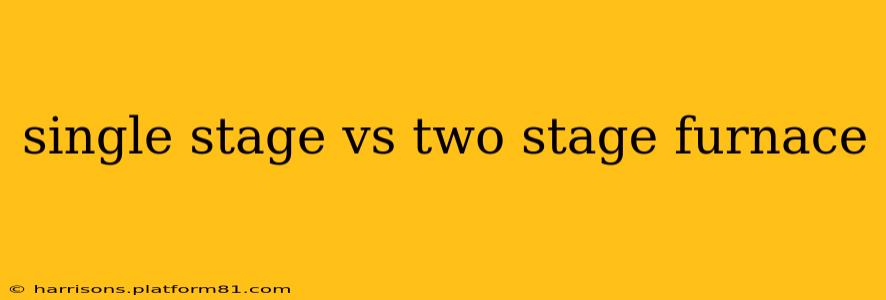Choosing the right furnace is a crucial decision for homeowners, impacting both comfort and energy bills. Two main types dominate the market: single-stage and two-stage furnaces. Understanding their differences is key to making an informed choice. This comprehensive guide breaks down the nuances of each, helping you determine which furnace best suits your needs and budget.
What is a Single-Stage Furnace?
A single-stage furnace operates in an on/off manner. Think of it like a light switch: either it's completely on, blasting hot air at full capacity, or it's completely off. While simple and generally less expensive upfront, this "all-or-nothing" approach can lead to significant temperature swings. Your home might feel too hot, then too cold, cycling between extremes throughout the day. This constant cycling also places more stress on the system, potentially shortening its lifespan.
What is a Two-Stage Furnace?
A two-stage furnace offers a more refined approach to heating. It operates at two different capacity levels: a low-stage setting for maintaining consistent temperature and a high-stage setting for rapid heating when needed. Imagine a dimmer switch rather than a light switch. The low stage gently warms your home, preventing those uncomfortable temperature swings. The high stage kicks in only when extra heating power is required, such as during particularly cold spells or when the system needs to catch up after a period of inactivity.
Single Stage vs Two Stage Furnace: Key Differences Summarized
| Feature | Single-Stage Furnace | Two-Stage Furnace |
|---|---|---|
| Operation | On/off | Two heating stages (low and high) |
| Temperature Control | Less precise, larger temperature swings | More precise, stable temperature |
| Energy Efficiency | Generally less efficient | Generally more efficient |
| Comfort Level | Can lead to uncomfortable temperature fluctuations | Provides more consistent comfort |
| Upfront Cost | Typically less expensive | Typically more expensive |
| Lifespan | Potentially shorter | Potentially longer |
| Maintenance | Generally simpler | Slightly more complex |
What are the benefits of a two-stage furnace?
Two-stage furnaces offer several compelling advantages:
- Improved Comfort: The consistent, even heating provided by the low-stage setting minimizes temperature fluctuations, resulting in a more comfortable living environment.
- Enhanced Energy Efficiency: By operating at a lower capacity for extended periods, two-stage furnaces consume less energy compared to single-stage units. This translates to lower energy bills over time.
- Longer Lifespan: The reduced cycling and strain on the system contribute to a potentially longer lifespan, saving you money on replacements in the long run.
- Better Air Quality: The consistent low-stage operation can reduce the amount of dust and allergens circulated throughout your home.
What are the benefits of a single-stage furnace?
While two-stage furnaces generally offer superior performance, single-stage models retain some advantages:
- Lower Initial Cost: Single-stage furnaces are typically cheaper to purchase and install than two-stage models. This is a significant factor for homeowners on a tight budget.
- Simpler Maintenance: Their simpler design generally translates to less complex maintenance procedures.
Which furnace is better for my home?
The best choice depends on your individual needs and priorities. Consider these factors:
- Budget: If budget is your primary concern, a single-stage furnace might be a viable option.
- Climate: In regions with extreme temperature variations, a two-stage furnace might provide better comfort and efficiency.
- Comfort Preferences: If you prioritize consistent comfort and hate temperature fluctuations, a two-stage furnace is the better choice.
- Long-Term Costs: While the initial cost is higher, a two-stage furnace's increased efficiency and longer lifespan could result in significant long-term savings.
How much more expensive is a two-stage furnace?
The price difference varies depending on factors like size, brand, and features. However, expect to pay a premium for a two-stage unit compared to a single-stage model. This added cost is often offset by long-term savings on energy bills and reduced maintenance.
Are two-stage furnaces more efficient?
Yes, two-stage furnaces are generally more energy-efficient than single-stage furnaces due to their ability to maintain consistent temperature with lower energy consumption.
What is the difference between a single-stage and a variable-speed furnace?
While we've focused on single-stage vs. two-stage, it's worth mentioning variable-speed furnaces. These offer even more precise control, modulating output across a wider range of speeds. They represent a step up from two-stage, offering the highest level of comfort and energy efficiency, but come with a higher price tag.
Ultimately, the decision between a single-stage and two-stage furnace is a personal one. Weighing the pros and cons, considering your budget and priorities, will help you make the best choice for your home and family. Consulting with a qualified HVAC professional is always recommended for personalized advice.
